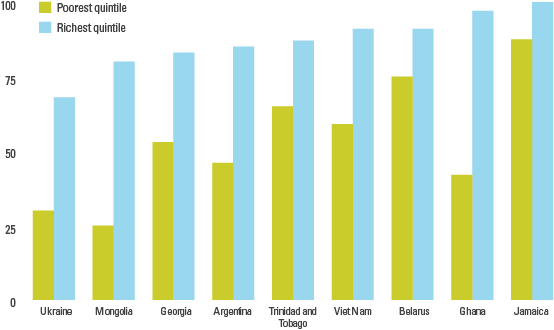The family and home environment are critical to a young child’s survival and development. However, access to good-quality care and education programmes outside the home are also important in providing children with the basic cognitive and language skills they need to flourish in school. Such programmes can also help foster social competency and emotional development. In fact, it is widely recognized that early childhood care and education form the foundation of a high-quality basic education.
That said, too few children are attending preschool programmes. And those that are tend to be from the richest 20 per cent of the population. Investing in early childhood education can be a powerful way to reduce gaps that often put children with low social and economic status at a disadvantage. Studies show that the returns on such investments are highest among poorer children, for whom these programmes may serve as a stepping stone out of poverty or exclusion.[1]
DATA SOURCES
The main source of nationally representative and comparable data on attendance in early childhood care and education programmes is the Multiple Indicator Cluster Surveys (MICS). Some Demographic and Health Surveys (DHS) and other national household surveys have also included questions on children’s attendance in preschool programmes.
Questions on attendance in organized early childhood care and education were first collected in the birth registration and early learning module during the second round of MICS (MICS2). For the third round of MICS (MICS3), conducted mainly in 2005 and 2006, information about preschool attendance was again collected in the birth registration and early learning module. Beginning with the fourth round of MICS (MICS4), questions on attendance in early childhood care and education were included in the consolidated early childhood development module included in the questionnaire for children under 5.
Mothers or primary caregivers are asked whether each child aged 36 to 59 months living in the household is currently attending any organized early learning or early childhood education programme, whether public or private, and for how many hours per week. In some cases, the question is customized to make specific reference to relevant country examples of early childhood education programmes.
MAIN INDICATOR
Across all rounds of MICS that have collected data on attendance in early childhood education, the standard indicator definition refers to the percentage of children aged 36 to 59 months who are attending an early childhood education programme. This means that it is possible to explore trends over time for several countries that have completed multiple rounds of MICS.
MICS MODULE ON EARLY CHILDHOOD DEVELOPMENT
MICS surveys have a standardized modules on early childhood development.
Download the MICS module on early childhood development (PDF)





